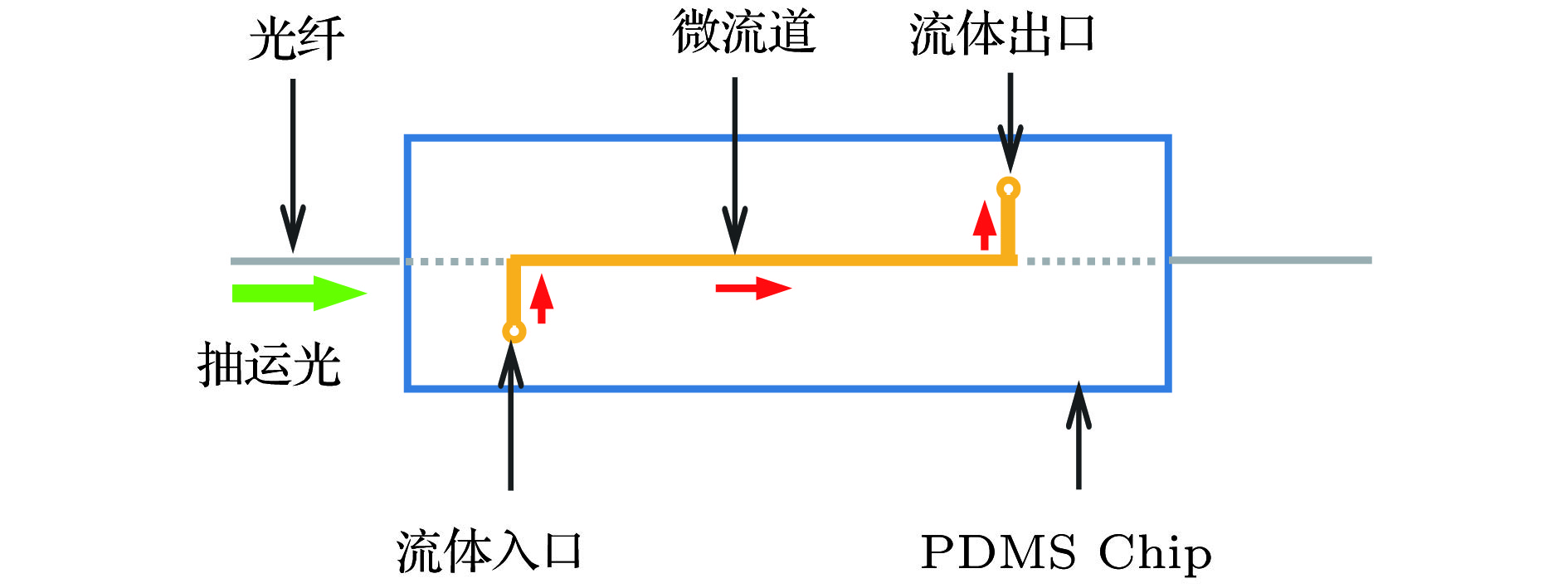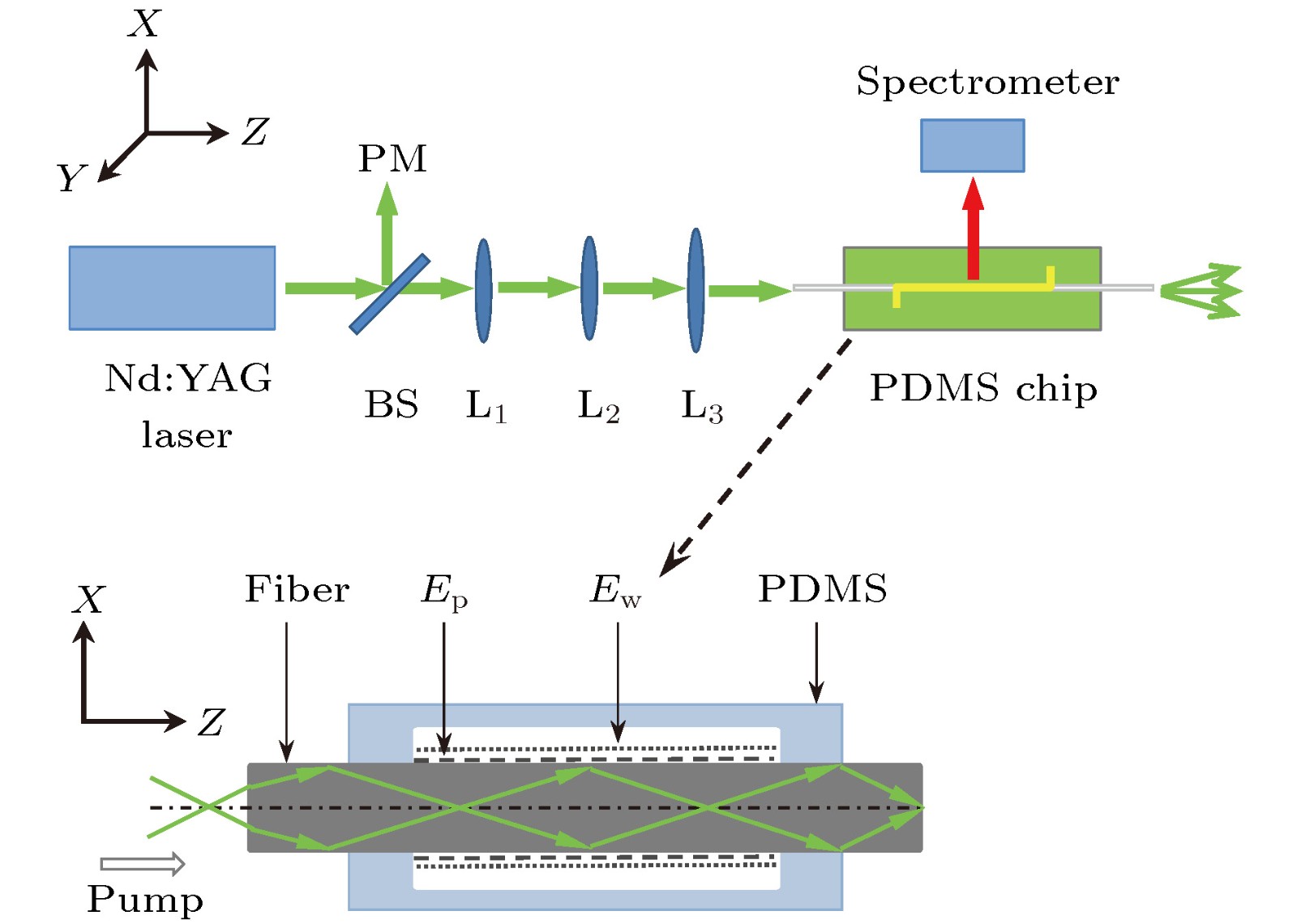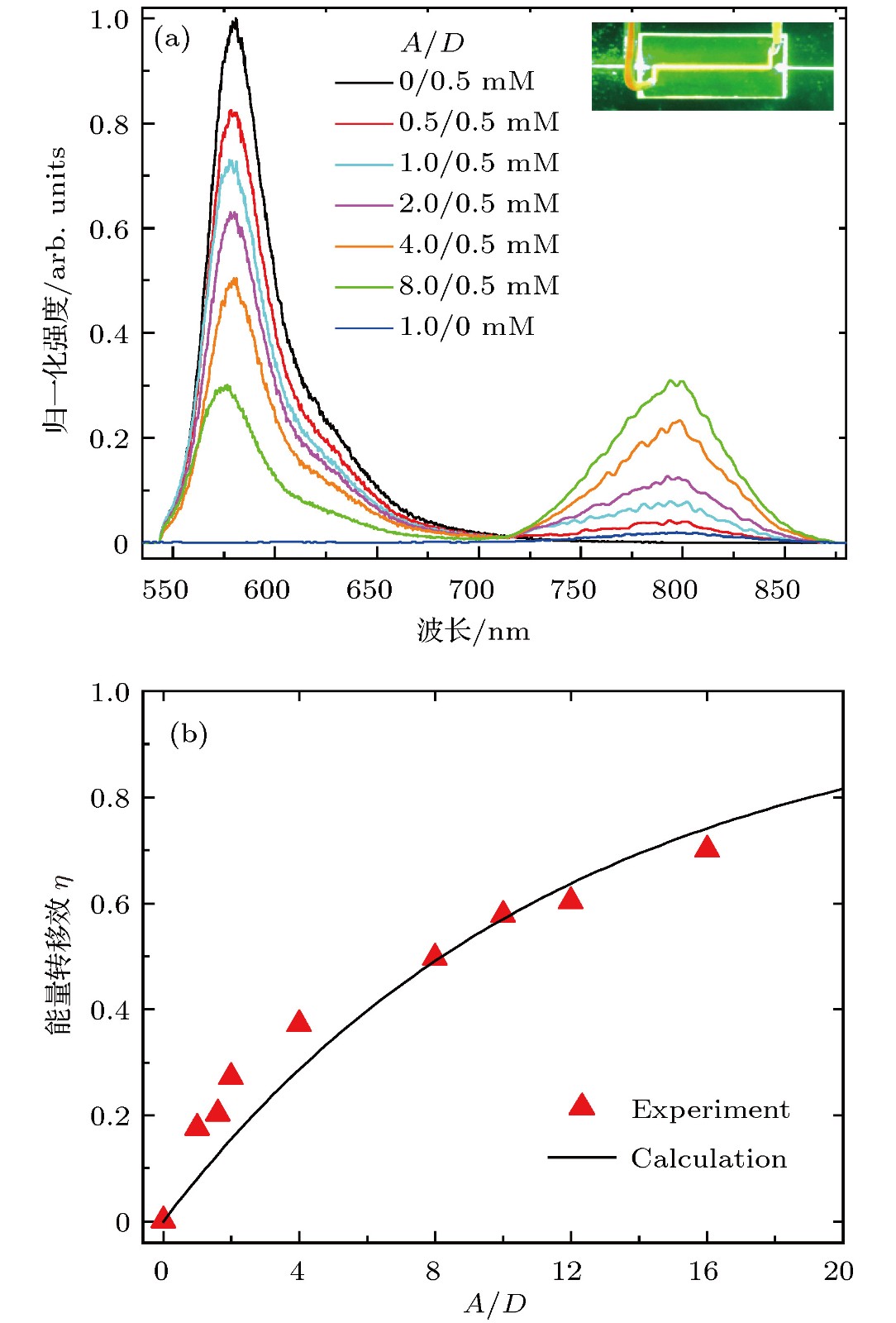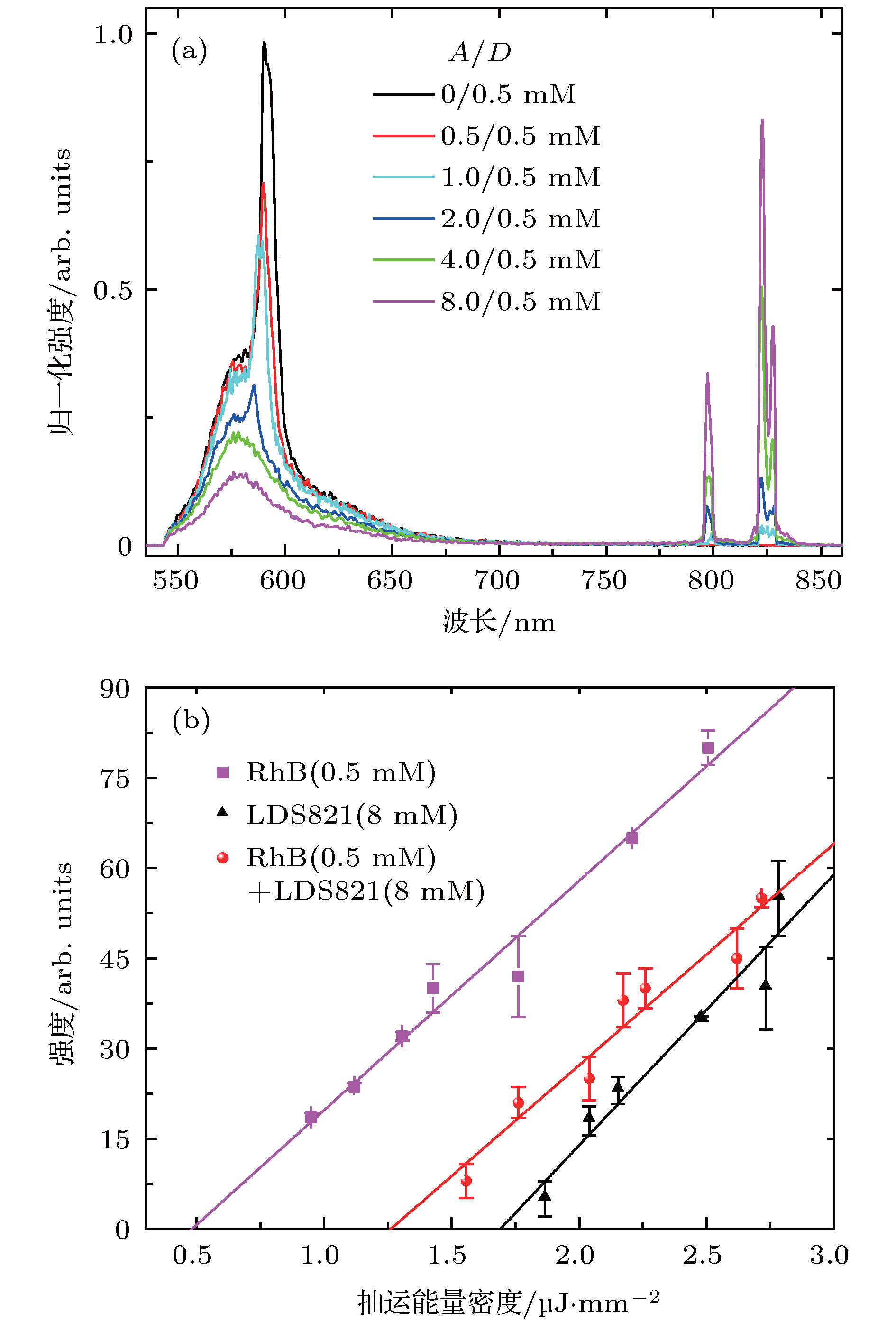-
A bare quartz fiber with single refractive index is implanted into a polydimethylsiloxane (PDMS) microfluidic channel. The lasing gain medium consists of fluorescence resonance energy transfer (FRET) donor-acceptor dye pair Rhodamine B (RhB)-LDS821 mixture solution, which has a lower refractive index than that of the optical fiber and flows in the PDMS microfluidic channel. The circular cross section of the optical fiber forms a ring resonator and hosts high-quality (Q) whispering gallery modes (WGMs). Pumping along the optical fiber axis, the FRET characteristic parameters, i.e., the FRET efficiency
$\eta $ and the Förster distance R0 of donor-acceptor dye pair, are firstly studied by using a continuous wave laser as a pump light source with a wavelength of 532 nm. The excited states are thencreated in the donor (RhB) by using a pulse laser with a wavelength of 532 nm and whose energy is transferred into the adjacent acceptor (LDS821) through the non-radiative FRET mechanism. Finaly, the emission of LDS821 iscoupled into the WGM of the ring resonator to lase. Due to the high energy transfer efficiency and high Q-factor, the acceptor shows a lasing threshold as low as 1.26${\text{μ}}{\rm J}$ /mm2.[1] Li Z, Psaltis D 2008 Microfluid. Nanofluid. 4 145
 Google Scholar
Google Scholar
[2] Holger S, Aaron R H 2011 Nat. Photon. 5 598
 Google Scholar
Google Scholar
[3] Chen Q, Zhang X, Sun Y, Ritt M, Sivaramakrishnan S, Fan X 2013 Lab on a Chip 13 2679
 Google Scholar
Google Scholar
[4] Wang C S, Chang T Y, Lin T Y, Chen Y F 2014 Sci. Reports 4 6736
[5] 李杰, 李蒙蒙, 孙立朋, 范鹏程, 冉洋, 金龙, 关柏鸥 2017 66 074209
 Google Scholar
Google Scholar
Li J, Li M M, Sun L P, Fan P C, Ran Y, Jin L, Guan B O 2017 Acta Phys. Sin. 66 074209
 Google Scholar
Google Scholar
[6] Mellors J S, Jorabchi K, Smith L M, Ramsey M 2010 Anal. Chem. 82 967
 Google Scholar
Google Scholar
[7] Vahala K J 2003 Nature 424 839
 Google Scholar
Google Scholar
[8] Humar M, Yun S H 2015 Nat. Photon. 27 572
[9] Zhang Y X, Meng W D, Yang H Y, Pu X Y 2015 Opt. Lett. 40 5101
 Google Scholar
Google Scholar
[10] Cerdán L, Enciso E, Martín V 2012 Nat. Photon. 6 621
 Google Scholar
Google Scholar
[11] Förster T 1959 Discuss Faraday Soc. 27 7
 Google Scholar
Google Scholar
[12] Ozelci E, Aas M, Jonas A, Kiraz A 2014 Laser Phys. Lett. 11 045802
 Google Scholar
Google Scholar
[13] Armstrong R L, Xie J G, Ruekgauer T E 1992 Opt. Lett. 17 943
 Google Scholar
Google Scholar
[14] Maslov V V 2008 4th International Conference on Advance Optoelectronics & Lasers Alushta, Crimea, Ukraine, September 29–October 4, 2008 p366
[15] Shopova S I, Cupps J M, Zhang P, Henderson E P, Lacey S, Fan X D 2008 Opt. Express 15 12735
 Google Scholar
Google Scholar
[16] Sun Y, Shopova S I, Wu C S 2010 Proc. Natl. Sci. Acad. USA 107 16039
 Google Scholar
Google Scholar
[17] Zhang Y X, Pu X Y , Zhu K, Feng L 2011 J. Opt. Soc. Am. B 28 2048
 Google Scholar
Google Scholar
[18] Sahoo H 2011 J. Photochem.Photobiol. C: Photochem. Rev. 12 20
 Google Scholar
Google Scholar
[19] Brackmann U 2000 Goettingen Lambda Physik Gmbh 1
[20] Stryer L, Haugland R P 1967 Proc. Natl. Sci. Acad. USA 58 719
 Google Scholar
Google Scholar
[21] Li Z, Psaltis D 2007 J. Sel. Top. Quantum Electron. 13 185
 Google Scholar
Google Scholar
[22] Zhang Y X, Pu X Y, Feng L, Han D Y, Ren Y T 2013 Opt. Express 21 12617
 Google Scholar
Google Scholar
[23] Bene L, Ungvári T, Fedor R, Damjanovich L 2014 Biochim. Biophys. Acta 1843 3047
 Google Scholar
Google Scholar
[24] Du J, Zhu T, Ma W, Cao W, Gu Q, Fan J, Peng X 2017 Ind. Eng. Chem. Res. 56 10591
 Google Scholar
Google Scholar
-
图 5 (a) 以RhB和LDS821分别作为能量供体和能量受体的归一化荧光辐射光谱, A/D为受体与供体浓度比值, 图中“A/D = 1.0/0 mM”表示没有供体时受体的辐射光谱, 其他值表示固定供体浓度为0.5 mM, 不同受体浓度所对应的FRET光谱, 插图为微流道中荧光辐射的实物图; (b)红色三角形是根据图5(a)计算得到的能量转移效率
$\eta $ 随A/D变化关系的实验值, 实线是根据(1)式得到的理论值Figure 5. (a) Normalized fluorescence spectra of RhB (donor) and LDS821 (acceptor); A/D, acceptor to donor ratio, A/D = 1.0/0 mM was collected for 1.0 mM acceptor in the absence of donor and the other spectra were collected for a constant donor concentration of 0.5 mM and the acceptor concentration changing from 0 to 8 mM; inset, the picture of fluorescent radiation generated in the PDMS microfluidic channel; (b) the red triangle is the experimental value of the energy transfer efficiency
$\eta $ as a function of A/D calculated from Fig. 5(a), and the solid line is the theoretical value calculted by formula (1).图 6 (a)不同A/D值对应的低等分辨率(光栅密度g = 150 g/mm)的FRET激光光谱, 供体浓度保持0.5 mM不变; (b)激光辐射峰强度随抽运光能量密度的变化关系; 供体峰值为585 nm, 阈值约为0.48
${\text{μ}}{\rm J}$ /mm2; A/D = 8/0.5 mM和A/D = 8/0 mM的LDS821的峰值均为822 nm, 其阈值分别为1.26${\text{μ}}{\rm J}$ /mm2和1.69${\text{μ}}{\rm J}$ /mm2Figure 6. (a) Low resolution (grating density = 150 g/mm) FRET lasing spectra for various A/D values, the donor concentration is fixed at 0.5 mM; (b) lasing peak intensity vs. pump energy density. The donor peak is at 585 nm and its lasing threshold is approximately 0.48
${\text{μ}}{\rm J}$ /mm2. The peaks of LDS821 for A/D = 8/0.5 mM and A/D = 8/0 mM are at 822 nm and their lasing threshold is approximately 1.26${\text{μ}}{\rm J}$ /mm2 and 1.69${\text{μ}}{\rm J}$ /mm2, respetively.图 7 不同A/D值对应的中等分辨率(光栅密度g = 1200 g/mm)的激光光谱 光谱图从上到下分别对应A/D = 0/0.5, 0.5/0.5, 1/0.5, 4/0.5, 8/0.5 mM; (a) RhB(供体)的激光光谱; (b) LDS821(受体)的激光光谱
Figure 7. Medium resolution (grating density = 1200 g/mm) lasing spectra for various A/D values. The spectra correspond to A/D = 0/0.5, 0.5/0.5, 1/0.5, 4/0.5, 8/0.5 mM from top to bottom: (a) Lasing spectra of RhB (donor); (b) lasing spectra of LDS821 (acceptor).
-
[1] Li Z, Psaltis D 2008 Microfluid. Nanofluid. 4 145
 Google Scholar
Google Scholar
[2] Holger S, Aaron R H 2011 Nat. Photon. 5 598
 Google Scholar
Google Scholar
[3] Chen Q, Zhang X, Sun Y, Ritt M, Sivaramakrishnan S, Fan X 2013 Lab on a Chip 13 2679
 Google Scholar
Google Scholar
[4] Wang C S, Chang T Y, Lin T Y, Chen Y F 2014 Sci. Reports 4 6736
[5] 李杰, 李蒙蒙, 孙立朋, 范鹏程, 冉洋, 金龙, 关柏鸥 2017 66 074209
 Google Scholar
Google Scholar
Li J, Li M M, Sun L P, Fan P C, Ran Y, Jin L, Guan B O 2017 Acta Phys. Sin. 66 074209
 Google Scholar
Google Scholar
[6] Mellors J S, Jorabchi K, Smith L M, Ramsey M 2010 Anal. Chem. 82 967
 Google Scholar
Google Scholar
[7] Vahala K J 2003 Nature 424 839
 Google Scholar
Google Scholar
[8] Humar M, Yun S H 2015 Nat. Photon. 27 572
[9] Zhang Y X, Meng W D, Yang H Y, Pu X Y 2015 Opt. Lett. 40 5101
 Google Scholar
Google Scholar
[10] Cerdán L, Enciso E, Martín V 2012 Nat. Photon. 6 621
 Google Scholar
Google Scholar
[11] Förster T 1959 Discuss Faraday Soc. 27 7
 Google Scholar
Google Scholar
[12] Ozelci E, Aas M, Jonas A, Kiraz A 2014 Laser Phys. Lett. 11 045802
 Google Scholar
Google Scholar
[13] Armstrong R L, Xie J G, Ruekgauer T E 1992 Opt. Lett. 17 943
 Google Scholar
Google Scholar
[14] Maslov V V 2008 4th International Conference on Advance Optoelectronics & Lasers Alushta, Crimea, Ukraine, September 29–October 4, 2008 p366
[15] Shopova S I, Cupps J M, Zhang P, Henderson E P, Lacey S, Fan X D 2008 Opt. Express 15 12735
 Google Scholar
Google Scholar
[16] Sun Y, Shopova S I, Wu C S 2010 Proc. Natl. Sci. Acad. USA 107 16039
 Google Scholar
Google Scholar
[17] Zhang Y X, Pu X Y , Zhu K, Feng L 2011 J. Opt. Soc. Am. B 28 2048
 Google Scholar
Google Scholar
[18] Sahoo H 2011 J. Photochem.Photobiol. C: Photochem. Rev. 12 20
 Google Scholar
Google Scholar
[19] Brackmann U 2000 Goettingen Lambda Physik Gmbh 1
[20] Stryer L, Haugland R P 1967 Proc. Natl. Sci. Acad. USA 58 719
 Google Scholar
Google Scholar
[21] Li Z, Psaltis D 2007 J. Sel. Top. Quantum Electron. 13 185
 Google Scholar
Google Scholar
[22] Zhang Y X, Pu X Y, Feng L, Han D Y, Ren Y T 2013 Opt. Express 21 12617
 Google Scholar
Google Scholar
[23] Bene L, Ungvári T, Fedor R, Damjanovich L 2014 Biochim. Biophys. Acta 1843 3047
 Google Scholar
Google Scholar
[24] Du J, Zhu T, Ma W, Cao W, Gu Q, Fan J, Peng X 2017 Ind. Eng. Chem. Res. 56 10591
 Google Scholar
Google Scholar
Catalog
Metrics
- Abstract views: 9755
- PDF Downloads: 85
- Cited By: 0

















 DownLoad:
DownLoad:














